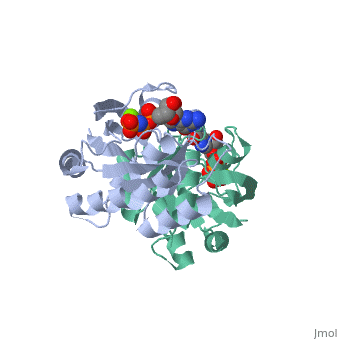GTPase HRas
 The RAS gene family was discovered due to the presence of two closely related retroviral cancer genes (oncogenes) within the Harvey and Kirsten RAt Sarcoma viruses. These retroviral oncogenes arose via capture of two normal cellular genes, H-RAS and K-RAS. A DNA transfection assay for oncogenes in human bladder cancer later identified the same H-RAS gene. Remarkably, the mutated oncogenic form of H-RAS differed from its normal counterpart by a single nucleotide change that caused a single amino acid substitution. Biochemical studies of purified RAS proteins revealed that they were capable of binding nucleotides, with a particularly high affinity for GTP. Extensive genetic, biochemical, and structural studies have established a model in which the RAS proteins function as molecular switches, as do related GTP-binding proteins. The RAS switch is "ON" when it binds , and is "OFF" when it binds . The changes in protein conformation between the and states are not very large. These changes primarily occur in two regions known as SWITCH I (yellow) and SWITCH II (magenta), and can be visualized by toggling the spin off and on in these partial space-filling models. The RAS protein itself has an intrinsic GTPase activity, thereby limiting the duration of time spent in the "ON" configuration. The binding sites of the nucleotide and the magnesium ion are revealed in high detail and consists of a characteristic (GXXXXGK[T/S]). For additional details see H-RasK117R mutant and User:Joseph Lipsick/RAS. The two most common oncogenic mutations in H-RAS affect residues and , both of which are adjacent to the bound GTP molecule. These oncogenic mutations greatly inhibit the intrinsic GTPase activity, thereby causing the RAS switch to spend more time in the "ON" position. The RAS proteins are present at the plasma membrane and transmit signals from transmembrance receptor tyrosine kinases (e.g. EGF and PDGF receptors) to downstream intracellular effectors that include the MAPK protein kinase cascade and the PI3K lipid kinase. Binding of EGF or PDGF to their receptors causes a relocalization of a Guanine Nucleotide Exchange Factor (GEF) protein to the plasma membrane. The structure of , a prototypic GEF, together with RAS implies that the GEF prys open the nucleotide binding site with a loss of bound GDP. The ten-fold higher ratio of GTP to GDP within the cell results in the replacement of RAS-GDP ("OFF" state) with RAS-GTP ("ON" state). Consistent with this model, gain-of-function mutations of GEF genes can be oncogenic (e.g. VAV oncogene) even in the absence of mutations of RAS. Conversely, a GTPase Activating Protein () can bind to RAS-GTP and increase the rate of the intrinsic RAS GTPase. Consistent with this model, loss-of-function mutations of GAP genes (e.g. NF1 tumor suppressor) can be oncogenic even in the absence of mutations of RAS itself. More details in Allosteric modulation of H-Ras GTPase. |
| ||||||||||
3D structures of GTPase Hras3D structures of GTPase Hras
Update June 2012
5p21, 221p, 1ioz, 1p2t, 3k8y, 3l8z, 3rry, 3tgp, 3lbh – hHRAS catalytic domain – human
1plj, 1plk, 1pll – hHRAS catalytic domain - Laue
221p, 421p, 521p, 621p, 721p, 821p, 1agp, 3i3s, 3k9n, 3lo5, 3k9l, 3oiu, 3oiv, 3oiw – hHRAS catalytic domain (mutant)
HRAS p21 complex with nucleotidesHRAS p21 complex with nucleotides
1crp, 1crq, 1crr, 1aa9 – hHRAS catalytic domain + GDP - NMR
1q21, 4q21 – hHRAS catalytic domain + GDP
6q21, 121p – hHRAS catalytic domain + GCP
1qra - hHRAS catalytic domain + GTP
1ctq, 4efl - hHRAS catalytic domain + GPPNHP
1xcm, 2cl0, 2rga, 2rgb, 2rgc, 2rgd, 2rge, 2rgg, 3kkm, 3kkn, 4efm, 4efn - hHRAS catalytic domain (mutant) + GPPNHP
1gnp, 1gnq - hHRAS catalytic domain + guanylate derivative
2lcf - hHRAS catalytic domain (mutant) + guanylate derivative - NMR
1p2s, 1p2u, 1p2v, 3rrz, 3rs0, 3rs2, 3rs4, 3rs7, 3rsl, 3rso - hHRAS catalytic domain + alcohol + guanylate derivative
3rs3, 3rs5 - hHRAS catalytic domain + small organic molecule + guanylate derivative
3ibh, 3lbi, 3lbn - hHRAS catalytic domain + salt + guanylate derivative
3l8y - hHRAS catalytic domain + cyclen + guanylate derivative
1clu, 1rvd, 1iaq, 1gnr - hHRAS catalytic domain (mutant) + GTP derivative
1lf0, 1zw6, 2cl6, 2cl7, 2clc, 2evw, 1jah, 1jai- hHRAS catalytic domain (mutant) + GTP
1lf5, 1xj0, 1zvq, 2cld, 2ce2, 2quz, 2x1v, 2q21 - hHRAS catalytic domain (mutant) + GDP
HRAS p21 complex with proteinHRAS p21 complex with protein
1wq1 - hHRAS catalytic domain + p120GAP catalytic domain
1bkd, 1nvw - hHRAS catalytic domain + son of sevenless-1
1nvu, 1nvv, 1nvx, 1xd2 - hHRAS catalytic domain (mutant) + son of sevenless-1 homolog
1k8r - hHRAS catalytic domain + Byr2 RAS-binding domain
2c5l - hHRAS catalytic domain (mutant) + phosphoinositide-specific phospholipase RA2 domain
2uzi, 2vh5 - hHRAS catalytic domain (mutant) + antibody
3ddc - hHRAS catalytic domain (mutant) + Ras association domain containing family protein RAS-binding domain
3kud - hHRAS catalytic domain + RAF proto-oncogene Ser/Thr-protein kinase
1lfd - hHRAS catalytic domain + Ral guanine nucleotide dissociation stimulator RAS-binding domain
ReferencesReferences
- Milburn, et al. Science. 1990. 247: 939-45.
- Wittinghofer and Pai. Trends Biochem Sci. 1991. 16: 382-7.
- Malumbres and Barbacid. Nature Rev Cancer. 2003. 3: 459-65.
- Bos, Rehmann, and Wittinghofer. Cell. 2007. 129: 865-77.
- Karnoub and Weinberg. Nature Rev Mol Cell Biol. 2008. 9: 517-531.
